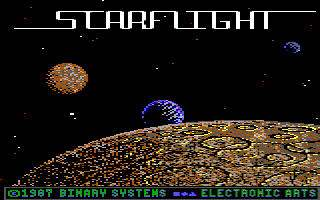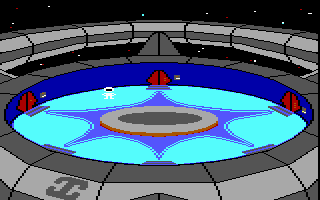 Iím not afraid to admit it:
StarFlight has touched me. I canít think about it without seizing up in fits of violent nostalgia; my eyes tear up and my normal ability to write semi-coherently disintegrates into expulsions of rampant fanboyism. Yes, I feel about
StarFlight the same way others feel about Star Wars or religion -- given half an excuse, Iíll happily yammer on about the Uhlek or the Numlok/Phlegmax war for hour upon hour, much to the dismay of anyone unfortunate enough to be near me at the time. Iíll try to rein all that in for the purposes of this review, but please consider yourself warned.
Iím not afraid to admit it:
StarFlight has touched me. I canít think about it without seizing up in fits of violent nostalgia; my eyes tear up and my normal ability to write semi-coherently disintegrates into expulsions of rampant fanboyism. Yes, I feel about
StarFlight the same way others feel about Star Wars or religion -- given half an excuse, Iíll happily yammer on about the Uhlek or the Numlok/Phlegmax war for hour upon hour, much to the dismay of anyone unfortunate enough to be near me at the time. Iíll try to rein all that in for the purposes of this review, but please consider yourself warned.
StarFlight debuted in 1986 on the IBM-PC and was eventually ported to the C64, Amiga, Atari ST and even the Sega Genesis. The version of the game I will comment on is the original IBM-PC edition, which I first experienced shortly after its initial release. The game was published by Electronic Arts and programmed by Binary Systems, a group of five ambitious men who had big ideas and the patience and technical know-how to implement them. They set out to create a space adventure that focused on exploration rather than combat, on story rather than shooting -- and they roundly succeeded.
 StarFlight is an adventure game set in space, but calling it simply a ďspace adventure gameĒ is not to do it justice. Itís more like a science-fiction novel that unfolds within the confines of a computer game. Story is essential, but at no point does it get in the way of the gameplay. The
back story, in abbreviated form, is this: itís the year 4619, a long time after the collapse of the once-great Old Earth Empire. The last remaining Earth colony, the planet Arth, has finally rediscovered space flight after a long dark age. You are in command of an Arth space vessel. Your mission starts out as one of general exploration, but quickly becomes one of greater urgency when scientists discover that stars throughout the galaxy are exploding, eradicating all planetary life. You must discover the cause of this phenomenon and stop it before the wave of flaring suns reaches Arthís solar system.
StarFlight is an adventure game set in space, but calling it simply a ďspace adventure gameĒ is not to do it justice. Itís more like a science-fiction novel that unfolds within the confines of a computer game. Story is essential, but at no point does it get in the way of the gameplay. The
back story, in abbreviated form, is this: itís the year 4619, a long time after the collapse of the once-great Old Earth Empire. The last remaining Earth colony, the planet Arth, has finally rediscovered space flight after a long dark age. You are in command of an Arth space vessel. Your mission starts out as one of general exploration, but quickly becomes one of greater urgency when scientists discover that stars throughout the galaxy are exploding, eradicating all planetary life. You must discover the cause of this phenomenon and stop it before the wave of flaring suns reaches Arthís solar system.
You begin your career in Starport, Arthís chief orbital facility and your base of operations. In Starport, you can read news reports, outfit your ship with weapons and other systems, create and train crew members, buy and sell goods you acquire while exploring the galaxy, and so on. In short, all of the RPG-like functions essential to managing your mission can be performed here. All of Starportís utilities are accessed through convenient menus navigated through keystrokes -- as indeed are all functions in the game. Although you may find the multitude of options daunting at first, youíll quickly master them. Having access to the original game manual, however, certainly helps.
 Useful as the facility is, you canít save the galaxy by simply hanging around Starport. Besides, youíll quickly discover that you donít have enough money to buy all the equipment and personnel training you want. Buy what you can (I recommend training your Navigator and Science Officer first), then hit the Docking Bay to blast off.
Useful as the facility is, you canít save the galaxy by simply hanging around Starport. Besides, youíll quickly discover that you donít have enough money to buy all the equipment and personnel training you want. Buy what you can (I recommend training your Navigator and Science Officer first), then hit the Docking Bay to blast off.
After leaving Starport, youíll find yourself in a solar system, just outside of Arthís orbit. Through menus and by using the arrow keys, you fly your ship and order your crew members to conduct necessary ship functions like conducting planetary scans. Land on a planet and disembark to begin exploring the surface in your all-purpose Terrain Vehicle. Youíll spend a lot of time planetside throughout the game, looking for valuable minerals (including the precious spaceship fuel, Endurium) and exotic life-forms for sale back at Starport. Occasionally youíll run across ruined structures from the Old Empire or from a mysterious race known only as ďThe Ancients.Ē The ruins may contain important messages or even technological artifacts. Altogether you may feel there a bit too much aimless searching and resource gathering in the game, but at least if you tire of it, you can divert your attention by mounting an interstellar expedition.
After earning some cash and beefing up your shipís engines and armaments, youíll be confident enough to leave the safety of Arthís system. At this point youíll realize just how VAST the galaxy really is. There are 270 solar systems in StarFlight and over 800(!) unique planets to explore. The game originally came packaged with a star map, an accessory that is not always easy to find these days, but fortunately the map can be accessed in-game through the Navigatorís menu. However, the map wonít tell you where to go. For that, youíll have to do some talking.
 There are a number of different alien races inhabiting this galaxy, each with its own language, culture and appearance. The Elowan, for example, are intelligent and gentle plant creatures, while the Spemin are posturing blobs just begging to have their pseudopods kicked. The mysterious Uhlek will kill you six times before you can even turn your ship around. Youíll encounter alien vessels while flying beyond Arthís system. Your Communications Officer handles the technical side of establishing contact (so train her well!), but you are given the option of what attitude to take and what subjects to discuss. It takes time to figure out the best approach to use when talking to the different races, but itís worth the effort. Gradually youíll discover the rich history of the galaxy and garner valuable clues about what planets you should visit. Keep a notebook handy!
There are a number of different alien races inhabiting this galaxy, each with its own language, culture and appearance. The Elowan, for example, are intelligent and gentle plant creatures, while the Spemin are posturing blobs just begging to have their pseudopods kicked. The mysterious Uhlek will kill you six times before you can even turn your ship around. Youíll encounter alien vessels while flying beyond Arthís system. Your Communications Officer handles the technical side of establishing contact (so train her well!), but you are given the option of what attitude to take and what subjects to discuss. It takes time to figure out the best approach to use when talking to the different races, but itís worth the effort. Gradually youíll discover the rich history of the galaxy and garner valuable clues about what planets you should visit. Keep a notebook handy!
Sometimes, however, communication fails and youíll have to resort to armed conflict. Combat is probably the weakest portion of the game. Your ship and those of the enemy are displayed as tiny icons in a small window. After issuing menu commands to raise shields and arm weapons, use the arrow keys to sluggishly dodge enemy fire while pounding the spacebar to shoot back. Itís less exciting than it sounds. Little strategy is required; the trick to winning is simply to have a more powerful ship than the enemy. Be careful though -- if youíre destroyed youíll have to resort to a saved game, an annoying process that requires you to create and restore backup files.
 The gameís graphics are somewhat sparse but fitting, provided you play the game in 16-color EGA mode and not 4-color CGA. By 1986 standards, the visuals are quite good, if a little abstract. Rather than try to capture a realistic look, the designers opted to present most scenes with abstractions like icons or fractal graphics. As a result, everything appears ďcomputerized,Ē not altogether an inappropriate look for a science-fiction game. The audio is minimalist -- PC speaker beeps and buzzes that were serviceable in í86, but hopelessly dated nowadays.
The gameís graphics are somewhat sparse but fitting, provided you play the game in 16-color EGA mode and not 4-color CGA. By 1986 standards, the visuals are quite good, if a little abstract. Rather than try to capture a realistic look, the designers opted to present most scenes with abstractions like icons or fractal graphics. As a result, everything appears ďcomputerized,Ē not altogether an inappropriate look for a science-fiction game. The audio is minimalist -- PC speaker beeps and buzzes that were serviceable in í86, but hopelessly dated nowadays.
Audiovisuals arenít everything however, and StarFlight manages to be a superior game despite some limitations in that department. The game affected me so profoundly because it conveys such a powerful sense of wonder and exploration. Never before had I played a game where I felt so free to go where I wanted, where the game universe was so vast and had so many secrets to uncover. And the storyline is a thing of beauty, revealed as it is through snippets of alien communications and hidden messages found in the ruins of some far-flung planet. Although replay value is low, you may be tempted to play on even after solving the game just to see if thereís any part of this intricate and vibrant universe you may have missed. If youíre not a sci-fi fan, youíll no doubt find it harder to appreciate. But if youíve ever longed to travel the stars, to experience the thrill of grand discovery among the timeless void, StarFlight will touch you too.
Notes: Because StarFlight is an older DOS game, you may have trouble running it on a modern PC. Visit The StarFlight & StarFlight 2 Fan Page for important patches and support material. http://www.geocities.com/lorenzolio/starflight.html
